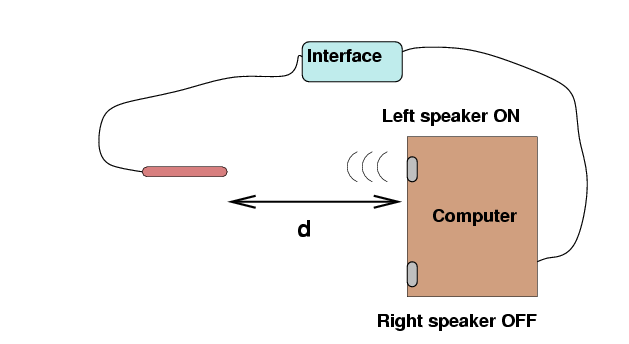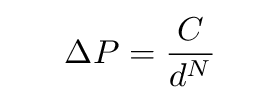 Copyright © Michael Richmond.
This work is licensed under a Creative Commons License.
Copyright © Michael Richmond.
This work is licensed under a Creative Commons License.
How does the amplitude of a sound wave change with distance?
Sally and Thad are studying sound waves in their
physics class. They argue about what should happen
if one moves away from a source of sound waves.
"The amplitude of the wave should decrease as
one-over-R," states Sally.
"No, no, the amplitude should decrease as
one-over-R-squared!" retorts Thad.
"That's why they call it the inverse square law!"

Who is right? You will decide by making some measurements
of actual sound waves.

Set up a computer, LabPro interface, and microphone
as shown.
- Download the LabPro file in the link below onto the Desktop
and double-click it to start LabPro.
- Download the file in the link below onto the Desktop
and execute it.
The program will allow you to create a nice sine wave with
your computer's speakers. Set it up as follows:
- In the "Frequency" box at upper left, type 300
- Click the green "+" box under "Macro" heading.
A "300" should appear in the list of frequencies.
Click this "300" in the list.
- Click the "Power" button to play the sound.
- Use the sliders to adjust the volume.
Uncheck the "Linked" button at the bottom.
Set the Right speaker's slider to 100 dB,
which should silence it.
Set the Left speaker's slider to about 6 dB.
- Place the microphone so that it is
10, 20, 30, 40, 50, 60 cm
from the left speaker.
At each distance, measure the amplitude of
the pressure in the sound wave as follows:
- Click the "Collect" button --
you should see a wave appear on the screen.
- Choose the "Analyze -> Curve Fit"
- Make sure the "Automatic" option is active
in the curve-fitter.
- From the list of possible curves to fit,
choose the "sin" item.
You should see a thin black line run through
the measurements. One of the parameters yields
the strength of the pressure created by the sound wave.
Write down this amplitude.
- Make a table with four columns.
Fill the first two columns with
"Distance from source" (cm),
and "Amplitude of wave pressure" (arbitrary units).
Now, let's look at a general case: suppose that the
pressure amplitude of sound waves decreases as
some power N of the distance from the source.

We can find the value of N if we take the logarithm
of both sides:

- In the final two columns of your table,
place the logarithm of each distance,
and the logarithm of the pressure amplitude.
- Make a graph of your values; choose axes so that
the slope of the line will yield N.
Who is right?
 Copyright © Michael Richmond.
This work is licensed under a Creative Commons License.
Copyright © Michael Richmond.
This work is licensed under a Creative Commons License.

 Copyright © Michael Richmond.
This work is licensed under a Creative Commons License.
Copyright © Michael Richmond.
This work is licensed under a Creative Commons License.




 Copyright © Michael Richmond.
This work is licensed under a Creative Commons License.
Copyright © Michael Richmond.
This work is licensed under a Creative Commons License.